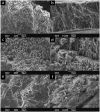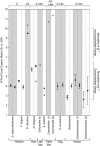Detecting Photosymbiosis in Fossil Scleractinian Corals
- PMID: 28842582
- PMCID: PMC5572714
- DOI: 10.1038/s41598-017-09008-4
Detecting Photosymbiosis in Fossil Scleractinian Corals
Abstract
The evolutionary success of reef-building corals is often attributed to photosymbiosis, a mutualistic relationship scleractinian corals developed with zooxanthellae; however, because zooxanthellae are not fossilized, it is difficult (and contentious) to determine whether ancient corals harbored symbionts. In this study, we analyze the δ15N of skeletal organic matrix in a suite of modern and fossil scleractinian corals (zooxanthellate- and azooxanthellate-like) with varying levels of diagenetic alteration. Significantly, we report the first analyses that distinguish shallow-water zooxanthellate and deep-water azooxanthellate fossil corals. Early Miocene (18-20 Ma) corals exhibit the same nitrogen isotopic ratio offset identified in modern corals. These results suggest that the coral organic matrix δ15N proxy can successfully be used to detect photosymbiosis in the fossil record. This proxy will significantly improve our ability to effectively define the evolutionary relationship between photosymbiosis and reef-building through space and time. For example, Late Triassic corals have symbiotic values, which tie photosymbiosis to major coral reef expansion. Furthermore, the early Miocene corals from Indonesia have low δ15N values relative to modern corals, implying that the west Pacific was a nutrient-depleted environment and that oligotrophy may have facilitated the diversification of the reef builders in the Coral Triangle.
Conflict of interest statement
The authors declare that they have no competing interests.
Figures



Similar articles
-
Photosymbiosis and the expansion of shallow-water corals.Sci Adv. 2016 Nov 2;2(11):e1601122. doi: 10.1126/sciadv.1601122. eCollection 2016 Nov. Sci Adv. 2016. PMID: 27847868 Free PMC article.
-
Fine-Scale Skeletal Banding Can Distinguish Symbiotic from Asymbiotic Species among Modern and Fossil Scleractinian Corals.PLoS One. 2016 Jan 11;11(1):e0147066. doi: 10.1371/journal.pone.0147066. eCollection 2016. PLoS One. 2016. PMID: 26751803 Free PMC article.
-
Evidence of photosymbiosis in Palaeozoic tabulate corals.Proc Biol Sci. 2013 Dec 4;281(1775):20132663. doi: 10.1098/rspb.2013.2663. Print 2014 Jan 22. Proc Biol Sci. 2013. PMID: 24307674 Free PMC article.
-
The Vulnerability and Resilience of Reef-Building Corals.Curr Biol. 2017 Jun 5;27(11):R528-R540. doi: 10.1016/j.cub.2017.04.047. Curr Biol. 2017. PMID: 28586690 Review.
-
Conservation genetics and the resilience of reef-building corals.Mol Ecol. 2006 Nov;15(13):3863-83. doi: 10.1111/j.1365-294X.2006.03026.x. Mol Ecol. 2006. PMID: 17054489 Review.
Cited by
-
Coral photosymbiosis on Mid-Devonian reefs.Nature. 2024 Oct 23. doi: 10.1038/s41586-024-08101-9. Online ahead of print. Nature. 2024. PMID: 39443794
-
Biotic interactions and their consequences for macroevolution: learning from the fossil record and beyond.Paleobiology. 2008 Apr;62(4):715-995. doi: 10.1111/j.1558-5646.2008.00317.x. Epub 2008 Apr 2. Paleobiology. 2008. PMID: 39239253 Free PMC article.
-
Giant clam growth in the Gulf of Aqaba is accelerated compared to fossil populations.Proc Biol Sci. 2021 Aug 25;288(1957):20210991. doi: 10.1098/rspb.2021.0991. Epub 2021 Aug 25. Proc Biol Sci. 2021. PMID: 34428968 Free PMC article.
-
Photosymbiosis in Late Triassic scleractinian corals from the Italian Dolomites.PeerJ. 2021 Mar 16;9:e11062. doi: 10.7717/peerj.11062. eCollection 2021. PeerJ. 2021. PMID: 33777534 Free PMC article.
-
First sequencing of ancient coral skeletal proteins.Sci Rep. 2020 Nov 10;10(1):19407. doi: 10.1038/s41598-020-75846-4. Sci Rep. 2020. PMID: 33173075 Free PMC article.
References
-
- Stanley, G. D. & van de Schootbrugge, B. The evolution of the coral-algal symbiosis in Coral Bleaching: patterns, processes, causes and consequences (eds. van Oppen, M. J. H. & Lough, J. M.) 7–19 (Springer, 2009).
-
- Tambutté S, et al. Coral biomineralization: From the gene to the environment. J. Exp. Mar. Biol. Ecol. 2011;408:58–78. doi: 10.1016/j.jembe.2011.07.026. - DOI
-
- Goreau TF, Goreau NI. The physiology of skeleton formation in corals. II. Calcium deposition by hermatypic corals under various conditions in the reef. Biol. Bull. 1959;117:239–250.
-
- Allemand D, et al. Biomineralisation in reef-building corals: From molecular mechanisms to environmental control. Comptes Rendus-Palevol. 2004;3:453–467. doi: 10.1016/j.crpv.2004.07.011. - DOI
Publication types
MeSH terms
Substances
LinkOut - more resources
Full Text Sources
Other Literature Sources
Miscellaneous


